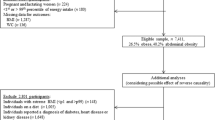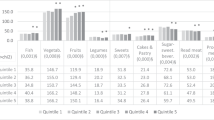Abstract
OBJECTIVES:
To establish whether choice and availability of takeaway and restaurant food consumption are associated with increased obesity.
DESIGN:
Crossroads Undiagnosed Disease Study: a cross-sectional study undertaken between June 2001 and March 2003.
SETTING:
A regional centre and six shire capitals of variables size in rural Victoria, Australia.
PARTICIPANTS:
In total, 1454 residents of randomly selected households.
MEASUREMENTS:
Obesity (by body mass index (BMI) or waist circumference), weekly recreational activity, self-reported frequency of takeaway consumption, number of local takeaway and restaurant food outlets in the area.
RESULTS:
The prevalence of obesity ranged from 25.5–30.8% and was higher than the general Australian population among both men and women. Those in the regional centre were less likely than those in large and small shire capitals to participate in recreational activity of 150 min or more (39.7 vs 48.4%, 46.0% respectively, P=0.023) and yet reported better access to facilities and amenities for physical activity. Recreational activity of ≥150 min/week was associated with 0.75 (0.58–0.97) fold less risk of obesity. BMI was unrelated to takeaway consumption. Waist circumference was significantly lower among those eating no takeaways, but similar whether takeaways were consumed <1/month or ≥1/week. Increased takeaway consumption was associated with increased consumption of higher fat preparations of dairy and meat products. Availability of takeaway outlets and restaurants was unrelated to obesity.
CONCLUSION:
The obesity epidemic exists among those without significant consumption of or availability to takeaway foods. In a setting of easy availability of food, the obesity epidemic relates strongly to reduced physical activity, but not to consumption of takeaway food.
This is a preview of subscription content, access via your institution
Access options
Subscribe to this journal
Receive 12 print issues and online access
$259.00 per year
only $21.58 per issue
Buy this article
- Purchase on Springer Link
- Instant access to full article PDF
Prices may be subject to local taxes which are calculated during checkout

Similar content being viewed by others
References
Visscher TLS, Seidell JC . The public health impact of obesity. Annu Rev Public Health 2001; 22: 355–375.
French SA, Story M, Jeffrey RW . Environmental influences on eating and physical activity. Annu Rev Public Health 2001; 22: 309–335.
Centers for Disease Control. Trends in intake of energy and macronutrients—United States. 1071-2000. MMWR 2004; 53: 80–82.
Harnack L, Stang J, Story M . Temporal trends in energy intake in the US: an ecological perspective. Am J Clin Nutr 2000; 71: 1478–1484.
Schlosser E . Fast food nation. Penguin: London, England; 2001.
Cameron AJ, Welbourn TA, Zimmet PZ, Dunstan DW, Owen N, Salmon J, Dalton M, Jolley D, Shaw JE . Overweight and obesity in Australia: the 1999–2000 Australian Diabetes, Obesity and Lifestyle Study (AusDiab). Med J Aust 2003; 178: 427–432.
Mokdad AH, Serdula MK, Dietz WH, Bowman BA, Marks JS, Koplan JP . The continuing epidemic of obesity in the United States. JAMA 2000; 284: 1650–1651.
Australian Bureau of Statistics. Census of population and housing. Australian Bureau of Statistics: Canberra; 2001.
Simmons D, Powell MJ, Williams DRR . Prevalence of diagnosed and previously undiagnosed diabetes in a predominantly Asian community: preliminary findings of the Coventry Diabetes Study. Br Med J 1989; 298: 18–21.
Simmons D, Harry T, Gatland B . Prevalence of known diabetes in different ethnic groups in inner urban South Auckland. NZ Med J 1999; 112: 316–319.
Dunstan DW, Zimmet PZ, Welborn TA, Shaw J, de Courten M, Cameron A, Sicree RA, Dwyer T, Colagiuri S, Jolley D, Knuiman M, Atkins R, Shaw JE . The rising prevalence of diabetes and impaired glucose tolerance: the Australian Diabetes, Obesity and Lifestyle Study. Diabetes Care 2002; 25: 829–834.
Salmon J, Owen N, Crawford D, Bauman A, Sallis JF . Physical activity and sedentary behavior: a population-based study of barriers, enjoyment, and preference. Health Psychol 2003; 22: 178–188.
Booth ML, Owen N, Bauman A, Gore CJ . Relationship between a 14-day recall measure of leisure-time physical activity and a submaximal test of physical work capacity in a population sample of Australian adults. Res Q Exerc Sport 1996; 67: 221–227.
Mandell C, Simmons D, Fleming C, Leakehe L, Gatland B . Validation of a diabetes knowledge and behaviour questionnaire. Asia Pac J Clin Nutr 1994; 3: 193–200.
Department of Human Services. Victorian Population Health Survey. Department of Human Services: Melbourne; 1999.
Simmons D, Fleming C, Voyle J, Fou F, Feo S, Gatland B . A pilot urban church-based programme to reduce risk factors for diabetes among Western Samoans in New Zealand. Diabetes Med 1998; 15: 136–142.
World Health Organisation. Obesity-preventing and managing the global epidemic: report of a WHO consultation on obesity. WHO: Geneva; 1998.
Dunstan DW, Zimmet PZ, Welborn TA, Cameron A, Shaw J, de Courten M, Jolley D, McCarty DJ . The Australian Diabetes, Obesity and Lifestyle Study (AusDiab)—methods and response rates. Diabetes Res Clin Pract 2002; 57: 119–129.
Newby PK, Muller D, Hallfrisch J, Qiao N, Andres R, Tucker KL . Dietary patterns and changes in body mass index and waist circumference in adults. Am J Clin Nutr 2003; 77: 1417–1425.
Paeratakul S, Ferdinand DP, Champagne CM, Ryan DH, Bray GA . Fast-food consumption among US adults and children: dietary and nutrient intake profile. J Am Diet Assoc 2003; 103: 1332–1338.
Kant AK, Graubard BI . Eating out in America, 1987–2000: trends and nutritional correlates. Prev Med 2004; 38: 243–249.
Hill JO, Wyatt HR . Relapse in obesity management: biology or behaviour? Am J Clin Nutr 1999; 69: 1064–1065.
Knowler WC, Barrett-Connor E, Fowler SE, Hamman RF, Lachin JM, Walker EA, Nathan DM . Reduction in the incidence of type 2 diabetes with lifestyle intervention or metformin. N Engl J Med 2002; 346: 393–403.
Tuomilehto J, Lindstrom J, Eriksson JG, Valle TT, Hamalainen H, Ilanne-Parikka P, Keinanen-Kiukaanniemi S, Laakso M, Louheranta A, Rastas M, Salminen V, Uusitupa M . Prevention of type 2 diabetes mellitus by changes in lifestyle among subjects with impaired glucose tolerance. N Engl J Med 2001; 344: 1343–1350.
Kahn EB, Ramsey LT, Brownson RC, Heath GW, Howze EH, Powell KE, Stone EJ, Rajab MW, Corso P . The effectiveness of interventions to increase physical activity. AM J Prev Med 2002; 22 (4S): 73–107.
Kumanyika SK . Minisymposium on obesity: overview and some strategic considerations. Annu Rev Public Health 2001; 22: 293–308.
Strong K, Trickett P, Titulaer, Bhatia K . Health in Rural and Remote Australia. Australian Institute of Health and Welfare: Canberra; 1998.
Burke V, Knuiman MW, Welbourn TA . Overweight and obesity. In: Welbourn TA (ed) The Busselton Study: mapping population health. Cardiovascular and respiratory disease risk factors in Buuselton, Australia. Australasian Medical Publishing Company: Sydney; 1998. pp 20–31.
Guest CS, O'Dea K, Hopper JL, Larkins RG . Hyperinsulinaemia and obesity in aborigines of south-eastern Australia, with comparisons from rural and urban Europid populations. Diabetes Res Clin Pract 1993; 20: 155–164.
Russell D, Parnell W, Wilson N . NZ Food: NZ people. Key results of the 1997 National Nutrition Survey. Ministry of Health: Wellington; 1999.
French SA, Lin BH, Guthrie JF . National trends in soft drink consumption among children and adolescents age 6 to 17 years: prevalence, amounts, and sources, 1977/1978 to 1994/1998. J Am Diet Assoc 2003; 103: 1326–1331.
Wareham NJ, Rennie KL . The assessment of physical activity in individuals and populations: why try to be more precise about how physical activity is assessed. Int J Obesity 1998; 22 (Suppl 2): S30–S38.
Acknowledgements
We thank the Crossroads team for their work and the local communities for their support. DS conceived and designed the study and analysed the data. AM and SE managed the study. All authors interpreted the data and wrote the paper. DS is guarantor.
Author information
Authors and Affiliations
Corresponding author
Additional information
Source of funding: The International Diabetes Institute and the University of Melbourne. The Department of Rural Health is funded under the Department of Health and Ageing Rural Health programme.
Competing interests: None.
Rights and permissions
About this article
Cite this article
Simmons, D., McKenzie, A., Eaton, S. et al. Choice and availability of takeaway and restaurant food is not related to the prevalence of adult obesity in rural communities in Australia. Int J Obes 29, 703–710 (2005). https://doi.org/10.1038/sj.ijo.0802941
Received:
Revised:
Accepted:
Published:
Issue Date:
DOI: https://doi.org/10.1038/sj.ijo.0802941
Keywords
This article is cited by
-
Weather and time factors impact on online food delivery sales: a comparative analysis of three Chinese cities
Theoretical and Applied Climatology (2023)
-
Associations between supermarket availability and body size in Australia: a cross-sectional observational study comparing state and territory capital cities
BMC Public Health (2021)
-
Longitudinal study of health, disease and access to care in rural Victoria: the Crossroads-II study: methods
BMC Public Health (2018)
-
Local descriptive body weight and dietary norms, food availability, and 10-year change in glycosylated haemoglobin in an Australian population-based biomedical cohort
BMC Public Health (2017)
-
Obesity, diet quality, physical activity, and the built environment: the need for behavioral pathways
BMC Public Health (2016)



